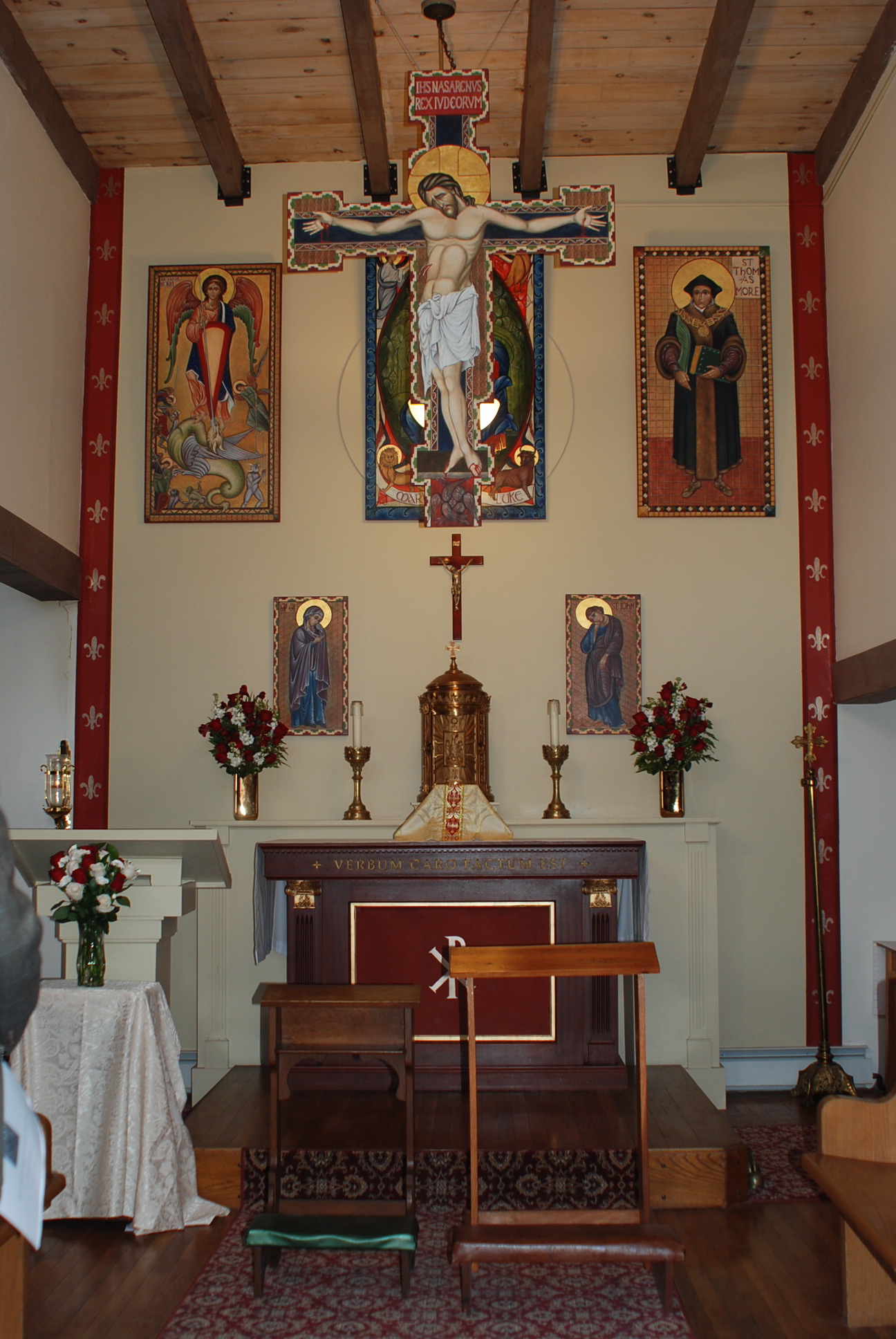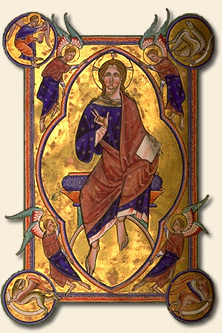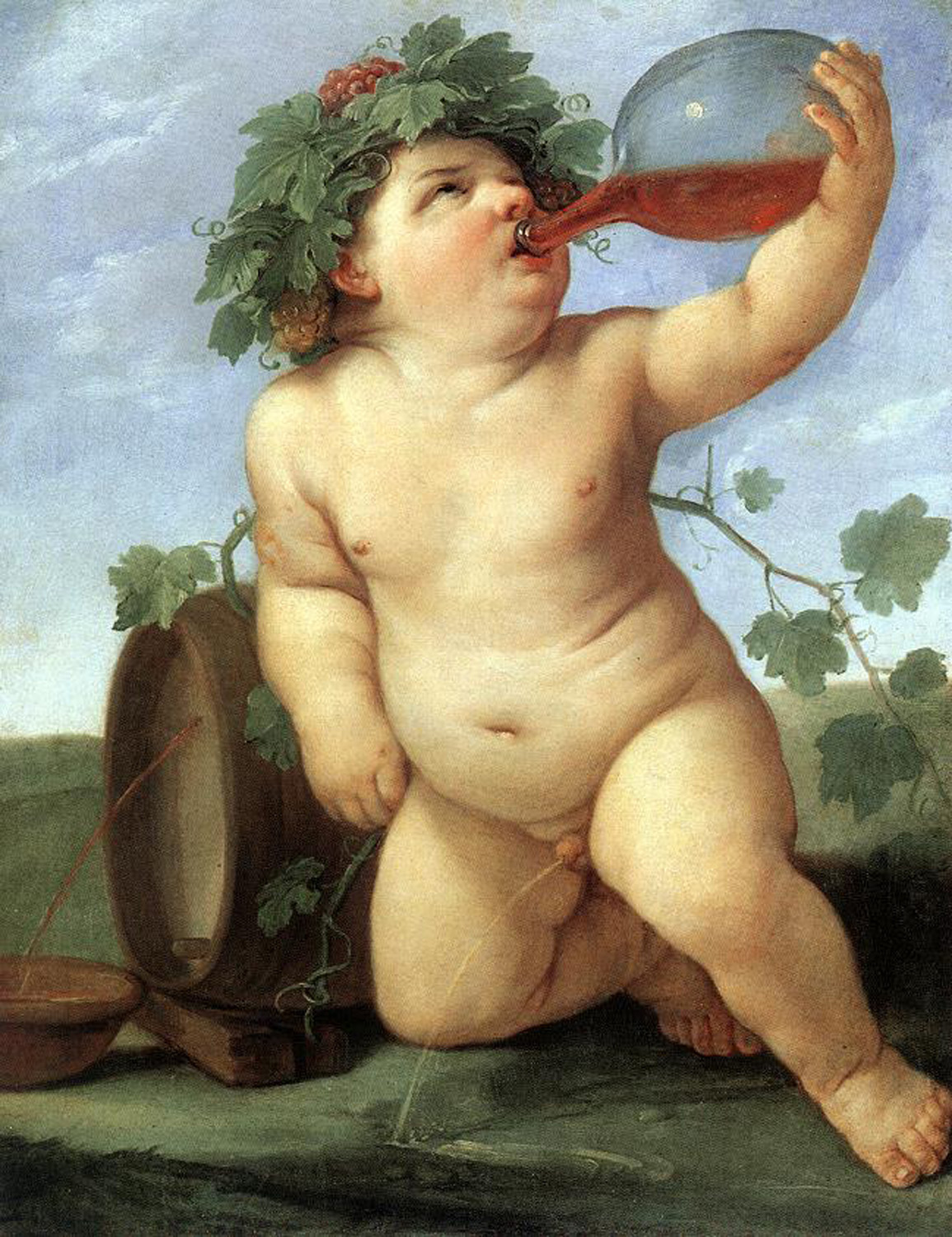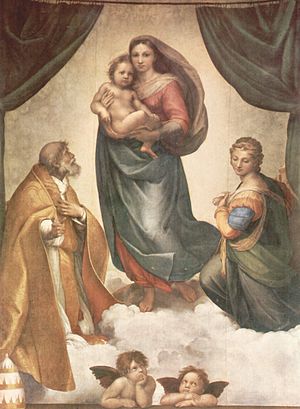As the new Heaven and Earth will represent the fullness of creation, we will also enjoy the fullness of our gifts.
Why Man Venerates Images of Angels, Even Though He is Higher than the Angels
 From John of Damascus's On the Divine Images
It is uncanny how often this sort of thing happens: if you read the Fathers, Scripture or the Liturgy, I find that just when I'm thinking about something I discover a passage that has something to say about it. The psalms particularly are like this. The seem to speak to the human person wherever he is emotionally and offer thoughts on just about any aspect of life. I will read something I have read many times, but this time it is commenting on something in a way I had never noticed before.
From John of Damascus's On the Divine Images
It is uncanny how often this sort of thing happens: if you read the Fathers, Scripture or the Liturgy, I find that just when I'm thinking about something I discover a passage that has something to say about it. The psalms particularly are like this. The seem to speak to the human person wherever he is emotionally and offer thoughts on just about any aspect of life. I will read something I have read many times, but this time it is commenting on something in a way I had never noticed before.
This has just happened to me again. Some of you may remember a piece posted very recently in which I expressed surprise that Leo the Great should say that man is higher than the angels. Then just a few days ago I read a passage by St John of Damascus. I was reading the third of his three treatises On the Divine Images, which he wrote against iconoclasm in the 8th century. The general theme of these is to stress the importance of holy images in safeguarding the doctrine of the Incarnation. In this passage he is discussing the veneration of images of those who not God, the saints and angels.
 He wants to make the point that all worship is due to God, but there are degrees of worship that are appropriate in different situations. So we adore God directly, but through veneration of images of his saints and angels, we bring worship and honour to God. To illustrate begins by pointing out that scripture relates that when Daniel and Joshua each encountered angels, they fell down and worshipped before them. First, he says, they were not seeing the angels, because an angel is an invisible spirit. Rather, they were seeing an image of an angel; and when they worshipped, they were not worshipping the angel but giving honour to God by showing honour to his ministering spirits. Similarly, he says, when we venerate images of the saints and angels, we are giving honour to God by honouring his friends. Furthermore, he says this fact that they are God's servants is the only reason that we would worship even an image of an angel, because we are higher than angels and such respect is not due an angel for itself. Here is the passage quoted directly. It is his third treatise, section 26:
He wants to make the point that all worship is due to God, but there are degrees of worship that are appropriate in different situations. So we adore God directly, but through veneration of images of his saints and angels, we bring worship and honour to God. To illustrate begins by pointing out that scripture relates that when Daniel and Joshua each encountered angels, they fell down and worshipped before them. First, he says, they were not seeing the angels, because an angel is an invisible spirit. Rather, they were seeing an image of an angel; and when they worshipped, they were not worshipping the angel but giving honour to God by showing honour to his ministering spirits. Similarly, he says, when we venerate images of the saints and angels, we are giving honour to God by honouring his friends. Furthermore, he says this fact that they are God's servants is the only reason that we would worship even an image of an angel, because we are higher than angels and such respect is not due an angel for itself. Here is the passage quoted directly. It is his third treatise, section 26:
'Joshua, the son of Nun did not see the angel as he is by nature, but and image for an angel by nature is not visible to bodily eyes, yet he fell down and worshipped and Daniel did likewise. Yet an angel is a creature, a servant, a minister of God, but not God. And they fell down and worshipped before the angels, not as God, but as God's ministering spirits. Shall I not make images 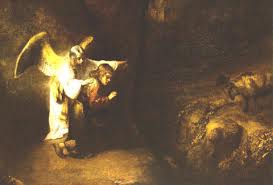 of friends? Shall I not honour them, not as Gods, but as the images of God's friends? Neither Joshua nor Daniel worshipped the angels they saw as gods. Neither do I worship an image as God, but through the images of Christ and the Holy Theotokos and of the saints, I bring worship and honour to God, because of the reverence with which I honour his friends. God did not unite himself with angelic nature, but with human nature. God did not become and angel; he became a man by nature and in truth. For surely it is not with angels that he is concerned, but with the seed of Abraham. The person of the Son of God did not assume an angelic nature, but a human nature. The angels do not share in this; they do not become partakers of the divine nature. But by the operation of grace, men do share in and become partakers of the divine nature; as many of them as do receive the Holy Body of Christ and drink his Blood since his person is united with the Godhead, and the two nature of Christ's Body which we eat are inseparably joined in his person. We partake of both natures, of His Body physically, and of His divinity spiritually, or rather of each in both. We did not become the same person as he is for we also first exist as individual persons; only then can we be united by the comingling of His Body and Blood. Therefore, we are greater than the angels, provided that we guard this perfect union by faithfully observing the commandments. for our humble nature is far inferior to the angels, because of death, and the heaviness of the body, but because by God's good will it has been united to Him, human nature has become superior to the angels. The angels stand in fear and trembling before our own nature, for He has raised us up with Him and made us sit with Him in the heavenly places in Christ Jesus and they will stand b in fear at the judgement. Nowhere does Scripture say that they will sit together with us, or become partakers of the divine nature. '
of friends? Shall I not honour them, not as Gods, but as the images of God's friends? Neither Joshua nor Daniel worshipped the angels they saw as gods. Neither do I worship an image as God, but through the images of Christ and the Holy Theotokos and of the saints, I bring worship and honour to God, because of the reverence with which I honour his friends. God did not unite himself with angelic nature, but with human nature. God did not become and angel; he became a man by nature and in truth. For surely it is not with angels that he is concerned, but with the seed of Abraham. The person of the Son of God did not assume an angelic nature, but a human nature. The angels do not share in this; they do not become partakers of the divine nature. But by the operation of grace, men do share in and become partakers of the divine nature; as many of them as do receive the Holy Body of Christ and drink his Blood since his person is united with the Godhead, and the two nature of Christ's Body which we eat are inseparably joined in his person. We partake of both natures, of His Body physically, and of His divinity spiritually, or rather of each in both. We did not become the same person as he is for we also first exist as individual persons; only then can we be united by the comingling of His Body and Blood. Therefore, we are greater than the angels, provided that we guard this perfect union by faithfully observing the commandments. for our humble nature is far inferior to the angels, because of death, and the heaviness of the body, but because by God's good will it has been united to Him, human nature has become superior to the angels. The angels stand in fear and trembling before our own nature, for He has raised us up with Him and made us sit with Him in the heavenly places in Christ Jesus and they will stand b in fear at the judgement. Nowhere does Scripture say that they will sit together with us, or become partakers of the divine nature. '
Are We Higher than the Angels and Archangels?
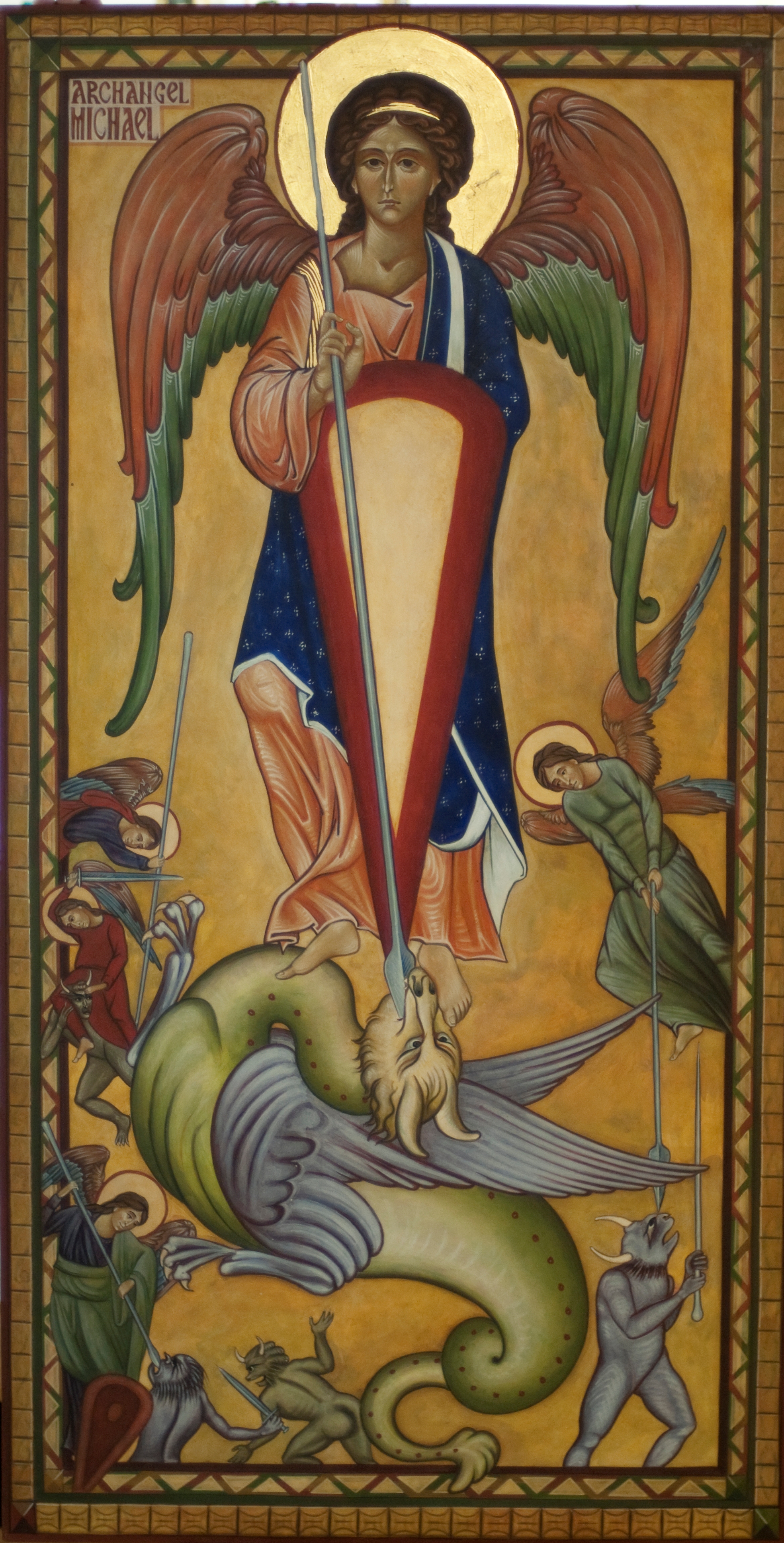 It may seem an impertinence to say so, but Pope Leo the Great seems to think so
Catholics are used to the idea that Our Lady is higher than the angels, but is it true for the rest of us? Here is what Pope Leo the Great has to say on the matter. It was surprising to me.
It may seem an impertinence to say so, but Pope Leo the Great seems to think so
Catholics are used to the idea that Our Lady is higher than the angels, but is it true for the rest of us? Here is what Pope Leo the Great has to say on the matter. It was surprising to me.
‘The blessed apostles together with all the others had been intimidated by the catastrophe of the cross, and their faith in the resurrection had been uncertain; but now they were so strengthened by the evident truth that when their Lord ascended into heaven, far from feeling any sadness, they were filled with great joy. Indeed that blessed company had a great and inexpressible cause for joy when it saw man’s nature rising above the dignity of the whole heavenly creation, above the ranks of angels, above the exalted status of archangels. Nor would there be any limit to its upward course until humanity was admitted to a seat at the right hand of the eternal Father, to be enthroned at last in the glory of him to whose nature it was wedded in the person of the Son.’ [Excerpt from a sermon by Pope Saint Leo the Great (Sermo 1 de Ascensione, 2-4: PL 54, 305-396) taken from the Office of Readings for Wednesday of the Sixth week of Easter]
If I am understanding this correctly then he is say we can be by grace at our final end in heaven be raised up as high as it possible to be, seated next to the Son, participating in mystery of the Trinity. The Ascension of the Lord was a sign that man's nature is to divine, although he cannot realise this by his own efforts, hence the need for God's grace. This is an extraordinary privilege.
St. Maximos the Confessor described this as a “total participation in Jesus Christ.” and said "A sure warrant for looking forward with hope to deification of human nature is provided by the incarnation of God, which makes man god to the same degree as God himself became man.... Let us become the image of the one whole God, bearing nothing earthly in ourselves, so that we may consort with God and become gods, receiving from God our existence as gods. For it is clear that He who became man without sin (cf. Heb. 4:15) will divinize human nature without changing it into the divine nature, and will raise it up for his own sake to the same degree as He lowered himself for man's sake.' (page 178 in the Philokalia, Vol II).
He also said that we will be “All that God is, except for an identity in being, one becomes when one is deified by grace.”
The one question that remains, then for us to think that we can be greater than the angels is this - is the same privilege offered to the angels too? If not, then it seems that we are by nature, greater than the angels (although in are fallen state in this life we are less than them!).
Comments from expert theologians please!
Is there room on that seat there for 6 billion more? The answer may well be yes! Christ is is seated in majesty, centre, 'at the right hand' of the Father.
Cherubim, Cherubs and Putti
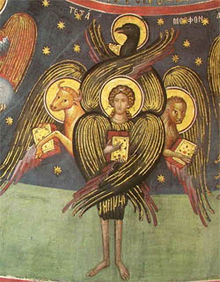 How should we paint cherubim? Painting a spiritual being is always going to be bit problematic. The representations that we see are most commonly based upon those instances in scripture where they have appeared visually. Even then it's not always straight forward. For example, the vision of Ezekiel describes a being that is a compound image of faces, wings, wheels, mulitiple eyes, fire and chrysolite (whatever that is).Reading through the biblical passage, its difficult to imagine how everything fits together and if I had been set the task without any tradition to refer to I don't know where I would start. Looking at the various traditional images, artists seem to pick up on particular details and represent those and do not seem to try too hard to create a single picture with everything present. It gives me the impression that perhaps what Ezekiel is describing may not be a steady image, but shimmering changing picture in which different things stand out at different times.
One thing that definitely doesn't come to mind, however, is a podgy baby. Quite how the figures of the Renaissance and the baroque equated these with any descriptions of cherubim from scripture I don't know. Perhaps there is a passage that I am unaware of that leads one in this direction artistically? If so, I am confident that a New Liturgical Movement reader will be able to direct me to the right place.
How should we paint cherubim? Painting a spiritual being is always going to be bit problematic. The representations that we see are most commonly based upon those instances in scripture where they have appeared visually. Even then it's not always straight forward. For example, the vision of Ezekiel describes a being that is a compound image of faces, wings, wheels, mulitiple eyes, fire and chrysolite (whatever that is).Reading through the biblical passage, its difficult to imagine how everything fits together and if I had been set the task without any tradition to refer to I don't know where I would start. Looking at the various traditional images, artists seem to pick up on particular details and represent those and do not seem to try too hard to create a single picture with everything present. It gives me the impression that perhaps what Ezekiel is describing may not be a steady image, but shimmering changing picture in which different things stand out at different times.
One thing that definitely doesn't come to mind, however, is a podgy baby. Quite how the figures of the Renaissance and the baroque equated these with any descriptions of cherubim from scripture I don't know. Perhaps there is a passage that I am unaware of that leads one in this direction artistically? If so, I am confident that a New Liturgical Movement reader will be able to direct me to the right place.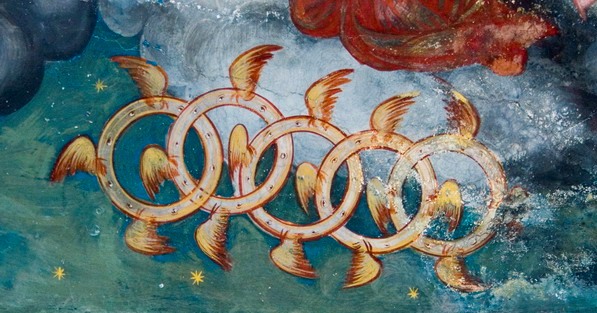 And then, even if we've established that we can employ this form, we have to be careful to distinguish between putti and cherubs. The source of this style of image is, as with all the art of the High Renaissance and baroque, classical sculpture. Putti are impish, 'little men' that are based on figures such as Eros, non-material beings with mischief in mind. By the baroque era cherubs were represented in exactly the same way. The distinction was simple, if the painting was sacred, then the person was a cherub, if is was secular/classical, then an identical representation would be a putto.
Regardless, this isn't something that will engage my thoughts for too long. I have no intention of representing either cherubs or putti in the baroque style. Much as I admire the baroque, this is one aspect I am not pushing to see again.
I'm going to stick to trying to paint wheels with wings and eyes made out of chrysolite...however hard that may be.
And then, even if we've established that we can employ this form, we have to be careful to distinguish between putti and cherubs. The source of this style of image is, as with all the art of the High Renaissance and baroque, classical sculpture. Putti are impish, 'little men' that are based on figures such as Eros, non-material beings with mischief in mind. By the baroque era cherubs were represented in exactly the same way. The distinction was simple, if the painting was sacred, then the person was a cherub, if is was secular/classical, then an identical representation would be a putto.
Regardless, this isn't something that will engage my thoughts for too long. I have no intention of representing either cherubs or putti in the baroque style. Much as I admire the baroque, this is one aspect I am not pushing to see again.
I'm going to stick to trying to paint wheels with wings and eyes made out of chrysolite...however hard that may be.
Images: first two, iconographic wall paintings (I'm not sure precisely where they are); third: Christ in Majesty, 12th century English with four cherubim shown, each with a different face visible.
Below: Bacchus (putto) and perhaps the most famous cherubs of all, in Raphael's Sistine Madonna






